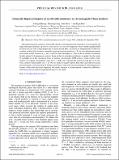| dc.contributor.author | Huang, Chengxi | |
| dc.contributor.author | Deng, Kaiming | |
| dc.contributor.author | Zhou, Jian | |
| dc.contributor.author | Kan, Erjun | |
| dc.date.accessioned | 2018-09-17T15:07:06Z | |
| dc.date.available | 2018-09-17T15:07:06Z | |
| dc.date.issued | 2018-09 | |
| dc.date.submitted | 2018-08 | |
| dc.identifier.issn | 2469-9950 | |
| dc.identifier.issn | 2469-9969 | |
| dc.identifier.uri | http://hdl.handle.net/1721.1/117850 | |
| dc.description.abstract | Although the quantum anomalous Hall (QAH) effect has been experimentally observed in several magnetically doped topological insulators, up to now, it only survives at a very low temperature. More suitable candidate QAH insulators that can work at high temperature are much desired. Here, we propose an experimentally feasible way to realize a robust QAH insulator: atomically dispersed transition metals (e.g., W) on a two-dimensional porous metal halide normal insulator (e.g., InI₃), which has been developed as a state-of-the-art chemical technology broadly adopted for homogeneous catalysis. Based on the first-principles calculations, we predict that the atomic W embedded in an InI₃ monolayer forms an intrinsic ferromagnetic QAH insulator, which exhibits robust uniform out-of-plane ferromagnetic order up to ∼160K and a topologically nontrivial band gap of 56 meV with a nonzero Chern number (|C|=2). We also study its magneto-optical Kerr effect and collective plasma excitation modes, which may help for further experimental verifications and measurement of interesting physical features of Dirac-like electronic dispersion. Our results introduce a feasible method to obtain the QAH effect, which may motivate intensive experimental interest in this field. | en_US |
| dc.publisher | American Physical Society | en_US |
| dc.relation.isversionof | http://dx.doi.org/10.1103/PhysRevB.98.115424 | en_US |
| dc.rights | Article is made available in accordance with the publisher's policy and may be subject to US copyright law. Please refer to the publisher's site for terms of use. | en_US |
| dc.source | American Physical Society | en_US |
| dc.title | Atomically dispersed tungsten on metal halide monolayer as a ferromagnetic Chern insulator | en_US |
| dc.type | Article | en_US |
| dc.identifier.citation | Huang, Chengxi et al. "Atomically dispersed tungsten on metal halide monolayer as a ferromagnetic Chern insulator." Physical Review B 98, 11 (September 2018): 115424 © 2018 American Physical Society | en_US |
| dc.contributor.department | Massachusetts Institute of Technology. Research Laboratory of Electronics | en_US |
| dc.contributor.mitauthor | Zhou, Jian | |
| dc.relation.journal | Physical Review B | en_US |
| dc.eprint.version | Final published version | en_US |
| dc.type.uri | http://purl.org/eprint/type/JournalArticle | en_US |
| eprint.status | http://purl.org/eprint/status/PeerReviewed | en_US |
| dc.date.updated | 2018-09-14T18:00:21Z | |
| dc.language.rfc3066 | en | |
| dc.rights.holder | American Physical Society | |
| dspace.orderedauthors | Huang, Chengxi; Deng, Kaiming; Zhou, Jian; Kan, Erjun | en_US |
| dspace.embargo.terms | N | en_US |
| mit.license | PUBLISHER_POLICY | en_US |
